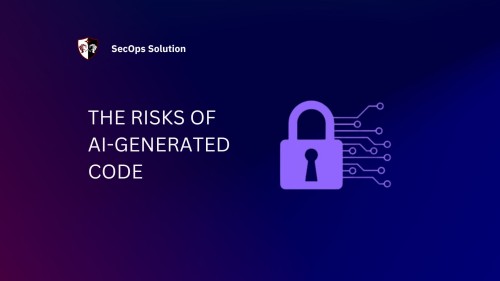Ai Risk & Security - Secure Coding

Ai Risk & Security - Secure Coding
Published 10/2024
Created by Yiannis Pavlosoglou,Jim Manico
MP4 | Video: h264, 1280x720 | Audio: AAC, 44.1 KHz, 2 Ch
Genre: eLearning | Language: English | Duration: 8 Lectures ( 1h 58m ) | Size: 1.2 GB
Master AI-Driven Code Generation with Secure, Efficient, and Reliable Development Practices
[/center]
What you'll learn:
Understand the top 10 risks in AI generated code for 2025.
Harness AI-driven tools like GitHub Copilot while prioritizing security in software development.
Identify and mitigate risks like biases, deprecated practices, and security oversights in AI-generated code.
Apply secure coding principles to prompt engineering, ensuring robust and secure AI-generated code.
Evaluate AI-generated code using metrics like MTTF, MTTR, and cyclomatic complexity to ensure reliability.
Understand the architecture and inner workings of AI language models in software development.
Analyze real-world case studies of secure and insecure AI-generated code for practical insights.
Implement security best practices in AI-assisted software development using ethical considerations.
Avoid legal pitfalls such as unintentional inclusion of GPL-licensed code in AI-generated outputs.
Learn secure coding practices in frameworks like React, including input validation and CSRF protection.
Apply evaluation techniques to assess AI-generated code for security, reliability, and maintainability.
Requirements:
Beginners Welcome. No Advanced AI Experience Needed.
No programming experience needed. Basic programming knowledge is only required.
Familiarity with Software Development Processes.
Basic Understanding of AI Concepts (Optional)
Access to AI Coding Tools (GitHub Copilot, ChatGPT, Gemini, and similar).
Description:
This course bridges the gap between artificial intelligence and secure software development, equipping learners with the skills to harness AI-driven code generation tools while prioritizing security and best practices. By the end of the course, developers, AI enthusiasts, risk managers, and security professionals will be well-prepared to lead the charge in the evolving landscape of AI-assisted software development.Participants will delve into the architecture of AI language models, understanding their inner workings and how they can be effectively utilized in software development. The course starts with an introduction to AI in code generation, covering the history and evolution of AI in coding, and presenting current AI tools and technologies like GitHub Copilot and GPT-4. Learners will get hands-on experience through practical exercises and case studies, contrasting secure and insecure code generated by AI.The curriculum then addresses the benefits and risks of AI code generation, highlighting how AI can increase development speed and efficiency while also presenting potential risks such as biases and deprecated practices in training data. Participants will learn how to mitigate these risks through thorough evaluation and ethical considerations.A dedicated lecture on the top 10 risks for 2025 when it comes to AI code generation guides learners on what controls they need to implement to avoid these risks. This lecture explores the potential pitfalls associated with AI-generated code, such as biases, legal violations, deprecated practices, and security oversights. AI can accelerate development, but it also introduces challenges like algorithmic bias and unintentional inclusion of GPL-licensed code, potentially forcing projects into open-source. Examples, such as recruiting tools discriminating against women and commercial products using GPL-licensed code without proper compliance, highlight the importance of vigilance. The lecture also covers security issues, privacy leaks, logic errors in algorithms, and risks from deprecated APIs, mentioning common breaches. These real-world examples reinforce the need for proper controls and oversight when integrating AI into development workflows.The next two lectures demonstrate the process of transforming human language into secure AI-generated code. Participants learn key secure coding principles and how to craft effective prompts to guide AI models in producing secure code. The demonstration emphasizes prompt engineering, showing the difference between a simple prompt ("Generate a React login form") and a secure one ("Generate a React login form with input validation, CSRF protection, and secure handling against XSS"). Additionally, the lecture discusses secure coding practices in React, such as protecting against XSS attacks and ensuring client-side authentication workflows are robustIn lecture 6, participants will learn how to assess the reliability, security, and quality of AI-generated code using specific evaluation metrics. Key code reliability indicators such as Mean Time to Failure (MTTF), Mean Time to Repair (MTTR), and cyclomatic complexity are discussed. The importance of identifying security gaps, maintaining consistent performance, and fostering trust in AI tools are emphasized.Finally, the last lecture focuses on integrating the evaluation metrics from previous lectures into real-world scenarios. Demos are presented to showcase how these metrics can be applied to ensure that AI-generated code is not only functional but secure and maintainable. The lecture reinforces the idea that developers must "trust but verify" when it comes to AI-generated code, using both automated and manual techniques to confirm that the code meets security and performance expectationsThrough in-depth real-world case studies and expert insights, learners will gain practical knowledge to confidently leverage AI in their coding projects, ensuring the highest standards of security and reliability. This comprehensive course empowers learners to stay ahead of the curve, adapt to new AI advancements, and implement robust security measures in their projects, making it a valuable resource for anyone looking to excel in the field. Enrol today to transform your approach to secure and innovative software development.
Who this course is for:
Software developers, both novice and experienced, who want to integrate AI-driven code generation tools into their development process.
AI enthusiasts interested in applying machine learning to software development.
Security professionals looking to understand and mitigate risks associated with AI-generated code.
Tech leads and project managers aiming to leverage AI for rapid and secure development.
Startup founders who want to accelerate development with AI while ensuring code security.
Students and academics seeking practical knowledge of AI in secure software development.
Industry professionals from sectors like finance, healthcare, and e-commerce interested in AI applications in coding.
Risk managers and auditors who want to better understand the AI risks in code generation.
https://rapidgator.net/file/de3f3bef959754cf3e4e67b97835a07d/AI_Risk_&_Security_-_Secure_Coding.part2.rar.html
https://rapidgator.net/file/f9cdd8ab357fe7b01b6e3799d9710a3d/AI_Risk_&_Security_-_Secure_Coding.part1.rar.html
